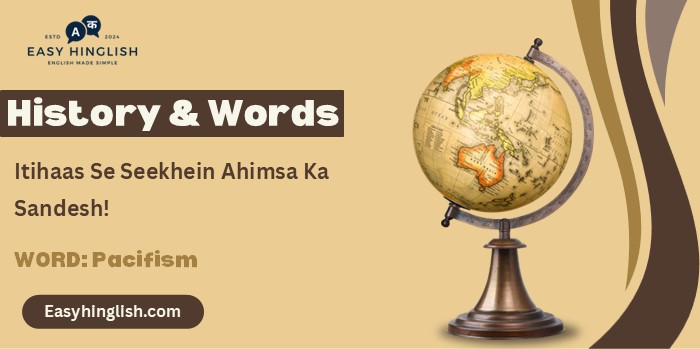History & Words: 'Pacifism' (October 9)
Welcome to 'History & Words.' Main Prashant hoon, Wordpandit aur Learning Inc. Network ka sansthapak. Yeh series meri bhasha seekhne ki lagan aur itihas ke prati ruchi ka sangam hai. Har kadi ek shabd aur uss se judi ek tithi par roshni daalti hai, jisse aapka shabdkosh badhta hai aur aap itihas ko gehraai se samajh paate hain. Aaiye, iss safar mein shabdon ke madhyam se samay mein pichhe chalein.
🔍 Word of the Day / Aaj ka Shabd: Pacifism
Pronunciation: /ˈpæsɪfɪzəm/ (PASS-uh-fizm)
🌍 Parichay (Introduction)
9 October 1939 ko New York Museum of Modern Art mein ek aisa painting display hui jo art history aur anti-war movement dono mein revolutionary milestone ban gayi. Pablo Picasso ka masterpiece "Guernica" America mein pehli baar exhibit hua, aur iss moment ne pacifism ki visual language ko forever define kar diya.
🌱 Shabd ka Utpatti (Etymology)
"Pacifism" word French "pacifisme" se aya hai, jo further Latin roots se derive hua hai. "Pax" ka matlab "peace" aur "-ficus" ka matlab "making" hota hai – literally "peace-making" ya "peace-creating."
📖 Mahatvapurn Shabdavali (Key Vocabulary)
- 🔑 Non-violence (Ahimsa): Active refusal to cause harm, Gandhi's philosophy ka core
- 🔑 Conscientious Objector: Jo military service se refuse kare moral/religious grounds par
- 🔑 Peace Activism: Organized efforts to prevent war aur promote peaceful solutions
- 🔑 Civil Disobedience: Peaceful resistance against unjust laws
- 🔑 Conflict Resolution: Disputes ko violence ke bina solve karne ka approach
🏛️ Itihasik Sandarbh (Historical Context)
Pacifism ka formal emergence 19th aur 20th century mein hua jab organized warfare increasingly destructive ban gaya. Industrial Revolution ne weapons technology ko transform kar diya, jisse mass destruction possible ho gaya.
Religious pacifism ki roots Christianity, Buddhism, aur Jainism mein deep hain. Quakers, Mennonites, aur Amish communities ne centuries se non-violent principles follow kiye hain. Eastern philosophies mein ahimsa (non-violence) fundamental tenet raha hai.
World War I ka unprecedented carnage ne many intellectuals aur artists ko pacifist ideology ki taraf attract kiya. Bertrand Russell, Albert Einstein, aur Virginia Woolf jaise prominent figures ne war ke futility par emphasis kiya. Lost Generation writers ne violence ka absurdity expose kiya.
Mahatma Gandhi ne pacifism ko political weapon banaya. Unka Satyagraha (truth-force) ne dikhaya ki non-violent resistance effective social change la sakti hai. Indian Independence Movement ne pacifist principles ka practical application demonstrate kiya.
Spanish Civil War (1936-1939) mein Guernica bombing ne civilian targets par deliberate attacks ka new era introduce kiya. Yeh total war concept tha jo combatants aur non-combatants ke beech distinction blur kar deta tha.

⏳ Samayrekha (Timeline)
- 1815: First organized peace societies form in Britain and America
- 1899-1907: Hague Peace Conferences attempt international arbitration
- 1914-1918: World War I sparks major pacifist movements
- 1920: League of Nations established with pacifist ideals
- 1930s: Gandhi's non-violent campaigns gain international attention
- 26 April 1937: Guernica bombing occurs during Spanish Civil War
- 9 Oct 1939: Picasso's "Guernica" first exhibited in America
- 1945: United Nations charter emphasizes peaceful conflict resolution
🌟 Is Din ka Mahatva (The Day's Significance)
9 October 1939 ko "Guernica" ka American debut sirf art exhibition nahi tha – yeh pacifist ideology ka powerful statement tha world war ke backdrop mein. Museum of Modern Art mein thousands of visitors ne war ka visual impact dekha aur pacifism ka emotional appeal experience kiya.
Picasso ne deliberately painting ko political weapon banaya tha. Unhone Nazi Germany ko condemn kiya tha aur Spanish Republic ko support kiya tha. American exhibition strategic timing thi – Hitler ka Poland invasion hua tha aur America neutral stance maintain kar raha tha.
"Guernica" ki imagery – screaming horse, bull, broken sword, aur dismembered bodies – ne war ka dehumanizing effect capture kiya. Cubist style ne fragmentation aur chaos represent kiya jo modern warfare ka characteristic hai. Black, white, aur grey palette ne death aur destruction ka atmosphere create kiya.
American audience ka response overwhelming tha. Art critics, political activists, aur general public ne pacifist message ko embrace kiya. Exhibition ne fundraising bhi ki Spanish refugees ke liye, jo art aur activism ka practical combination tha.
International impact immediate tha. "Guernica" ne anti-fascist sentiment strengthen kiya aur pacifist movements ko visual symbol provide kiya. World War II ke dauran yeh painting resistance aur hope ka icon ban gayi.
💬 Prasiddh Ukti (Quote)
"My whole life as an artist has been nothing more than a continuous struggle against reaction and the death of art. How could anybody think for a moment that I could be in agreement with reaction and death?" — Pablo Picasso (on "Guernica" and his pacifist stance)
🔮 Aaj Ka Matlab aur Chintan (Modern Usage and Reflection)
Aaj pacifism complex global context mein relevant hai. Nuclear weapons, terrorism, cyber warfare, aur climate conflicts ne new challenges create kiye hain peaceful resolution ke liye. International organizations like UN Peacekeeping Forces pacifist principles ko practical framework mein implement karte hain.
🏛️ Virast (Legacy)
"Guernica" ka legacy art world se beyond hai. Yeh UNESCO's headquarters mein displayed hai as permanent peace symbol. Anti-war protests mein iska reproduction universal peace icon ke roop mein use hota hai. Digital age mein yeh memes, social media campaigns, aur virtual exhibitions mein pacifist message spread karta hai.
Pacifist ideology ne international law ko shape kiya hai. Geneva Conventions, International Criminal Court, aur Responsibility to Protect doctrine mein pacifist principles embedded hain. Conflict prevention, peace-building, aur post-conflict reconstruction modern diplomacy ke core elements hain.
Educational systems mein peace studies ab academic discipline hai. Universities mein conflict resolution programs aur peace research centers establish hue hain. Next generation ko non-violent problem-solving teach kiya ja raha hai.
🔍 Tulnatmak Vishleshan (Comparative Analysis)
1939 mein pacifism idealistic philosophy considered hoti thi jo practical politics mein ineffective lagti thi. World War II ka context mein "just war" vs pacifism debate intense thi. Aaj preventive diplomacy aur early warning systems ne pacifist approach ko pragmatic strategy bana diya hai.
Picasso's era mein art ka political message controversial tha. Aaj artists, celebrities, aur influencers ka social responsibility expected hai. Cultural diplomacy aur soft power international relations ka important component ban chuka hai.
💡 Kya Aapko Pata Hai? (Did You Know?)
🎓 Antim Vichar (Conclusion)
Pacifism sirf war ka opposition nahi – yeh proactive peace-building ka philosophy hai. 9 October 1939 ko "Guernica" ka American exhibition ne dikhaya ki art, ideology, aur social change ka powerful combination kya kar sakta hai. Aaj bhi jab conflicts escalate karte hain, tab pacifist voices alternative solutions provide karte hain. Violence se violence ka cycle break karne ke liye pacifist approach hope ki ray banke aati hai.
📚 Aage Padhne Ke Liye (Further Reading)
- 📘 The Power of Nonviolence – Richard B. Gregg
- 📗 Gandhi's Truth – Erik H. Erikson
- 📙 The Art of Peace – Sun Tzu (alternative interpretation focusing on conflict avoidance)








